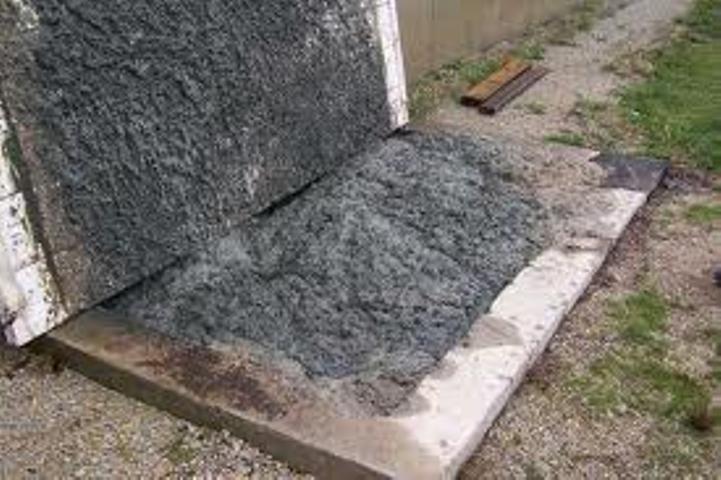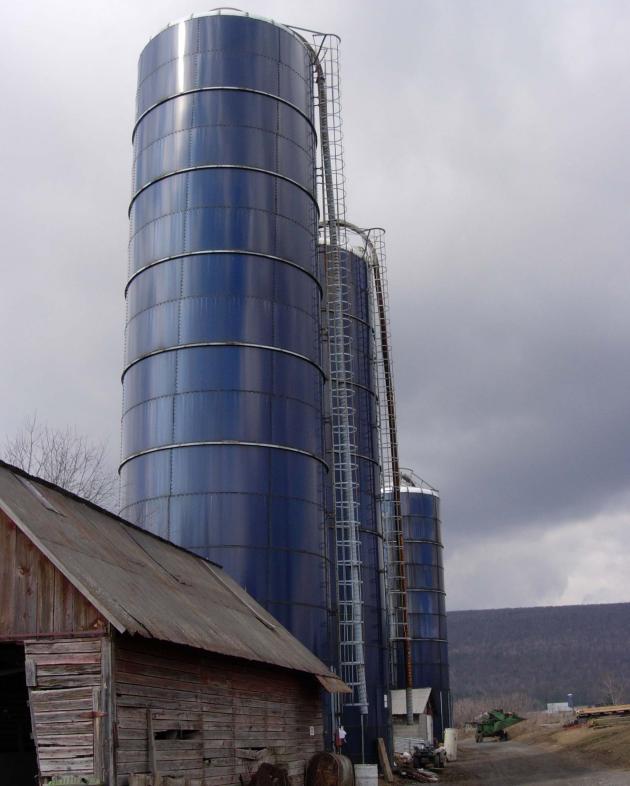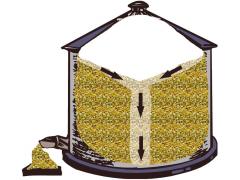
Foaming Manure – Source: Schimdt, UMN.
Use the following format to cite this article:
Manure foaming. (2012) Farm and Ranch eXtension in Safety and Health (FReSH) Community of Practice. Retrieved from http://www.extension.org/pages/63144/manure-foaming.
Foam in manure pits can be a danger both to animals and workers around the pits. Manure foaming occurs primarily in hog facilities, most commonly in the midwestern United States and Canada. The causes of manure foaming remain a mystery. Manure foaming is not predictable, and no known solutions work in every situation. It is therefore important to understand the risks posed by foaming manure and ways to reduce those risks.
Foam is defined as a mass of bubbles of gas on the surface of a liquid. Rather than being crusty or fluffy, foaming manure has a thick, mucous consistency. In manure pits, the bubbles do not burst but rather cling together.
One theory suggests that a specific microbial population causes foaming in manure pits. Another theory suggests that filamentous microorganisms (bacteria, fungi, or algae) are the cause. Neither theory has been confirmed, and research into the causes of manure foaming continues. Possible triggers include a high content of manure solids resulting from water conservation practices; cool weather patterns; reduced antibiotic use; feeding or diet adjustments; changes in DDGS; changes in corn, including genetic modifications; moldy and/or lightweight corn; and changes in the type or quantity of fat fed to the animals.
Dangers of Foaming Manure
Foam in manure pits may be linked to suffocation of hogs and incidents of fire and explosion. Methane (CH4) and hydrogen sulfide (H2S) are gases produced during the anaerobic breakdown of manure. Methane is a highly flammable gas that can lead to asphyxiation at high levels. The foam in manure pits captures methane, resulting in concentrations of methane in the foam that can be as high as 60% to 70% (600,000 to 700,000 ppm), which is higher than the concentration at which explosions can occur. When the foam bubbles are disturbed or broken, the captured methane is released at an explosive concentration of 5% to 20% (50,000 to 200,000 ppm). If there is an ignition source near an explosive concentration of methane, an explosion or a flash fire could occur.
Hydrogen sulfide is a colorless gas that smells like rotten eggs at low levels but can overcome a person’s sense of smell at levels of 100 ppm or higher. Hydrogen sulfide is heavier than air and can collect in the floor or lower areas of the pit. Exposure to hydrogen sulfide can cause eye and nose irritation, headache, nausea, and death.
In addition to the danger of explosion or fire, foaming manure poses an asphyxiation risk for both people and hogs when foam rises through the slats in a barn. Anyone working within the building or in the immediate area should be informed about the dangers of foaming manure, including the hazards of methane and hydrogen sulfide. No smoking should be permitted in or near the building.
Methods of Treatment
There are no proven ways to prevent manure foaming; at present, the focus remains on treating the symptoms. Below are some treatments that have yielded mixed results:
- Water – Spraying water, running sprinklers, or using soaker systems can break the bubbles in foam, releasing the methane in a relatively safe manner. If you are using water to break down foam, remember to follow recommended ventilation practices.
- Antifoam agents – There are several antifoam agents on the market. Although some have had limited success in reducing foam, none have proven effective on a consistent basis.
- Microbial enhancements – Microbial enhancements, typically in the form of feed or manure additives, have been effective on an inconsistent basis.
- Microbial control – Microbial control refers to changes in pH or oxygen levels or the use of antibiotics.
Due to the unpredictable nature of manure foaming, you should complete an audit of manure pits at least once a month. The purpose of the audit is to monitor pits for changes in manure consistency, increases in foam, and other such indicators of a potential problem. Based on information gathered in the audit, you can make necessary management decisions about using a treatment or changing the pumping schedule.
Emergency Action Plans
Develop an emergency action plan and review it annually with employees. It is especially important that anyone on-site during pit pumping receive training about the action plan. The emergency action plan should include a list of clean-up and containment practices in the event of an overflow, breach, leak, fire, or emergency land application. Due to the potential risk of fire or explosion, include in the action plan an evacuation route for employees. In addition, make sure that all employees know the location of fire extinguishers, hose cabinets, fire blankets, and other types of safety equipment. As a farm or ranch manager, make sure that you have necessary safety equipment and that it is in proper working order.
During pit pumping, remember to keep on hand the contact information of first responders, including the fire department, hospital, and police. When calling 911, give your name, location, contact information, and details about the emergency.
Precautions during Agitation and Pumping
When foaming manure is present, the risk of explosion necessitates additional precautions during pit agitation and pumping. It is strongly recommended that you pump manure pits when the barn is empty. People should remain outside of the building during agitation and pumping. After checking that everyone is out of the facility, add a physical barrier such as yellow caution tape or place warning signs to ensure that no one enters the facility during the process.
Any ignition sources should be turned off and locked out. Possible ignition sources include welders, heaters, motors, and other equipment, such as a feeding system, that uses electricity. (Because of the importance of ventilation, discussed in the next section, ventilation systems that use electricity may operate during agitation and pumping.)
Do not agitate the manure until the top of the manure surface is at least two feet below the floor slats. Agitate the manure below the surface of the liquid manure and stop the process if you can no longer agitate below the surface level. Agitate intermittently to reduce the risk of sudden gas release.
When possible, cover pump-out ports unless they are needed for agitation or manure load-out, and cover the pump-out around the agitation with a tarp. After pumping is complete, remember to secure manure pit covers.
Ventilation during Agitation and Pumping
Proper ventilation is one of the most important safety measures during agitation and pumping of manure pits. Regularly check your ventilation system to ensure that it is in proper working condition. Use a ventilation rate of 20 to 30 cfm per animal to dilute the methane concentration below 5%. Ventilation inlets, curtains, and pivot doors should be open during the ventilation process. For naturally ventilated barns, make sure that inlets and outlets are open. Circulation fans used in the summer do not provide the necessary air exchange needed during agitation or pumping, so plan these processes for days when wind is present to increase the amount of fresh air circulating through the building.
Ventilation for Curtain-Sided Barns
Ventilation procedures for curtain-sided barns differ slightly depending on weather conditions. When the weather is warm with winds over 5 mph, run exhaust fans while the curtains are open. On a calm day, the sidewall curtains should remain closed with the fans running. If, however, you are running more than half of the fans, the curtains should remain open during the pumping process. During colder weather, keep the curtains closed while running the exhaust fans.
If you are using a stir fan, use a horizontally directed fan rather than a fan directed downward, to reduce pockets of gas concentrations and to ensure that contaminated gas does not blow back onto hogs. Ventilate for approximately one to two hours after pumping and prior to entering the barn.
Ventilation for Tunnel-Ventilated Barns
During warm or hot weather, run all of the pit fans and a minimum of two tunnel fans. The procedure is slightly different for cold or moderate weather, but you should nevertheless run all of the pit fans and the 36 in. fan and open the tunnel curtain approximately 6 to 12 in. to provide air movement through the entire length of the barn. Remember to reduce the static pressure of the inlet velocity at the tunnel curtain from the regular setting of 800 fpm to 1,000 fpm to a lower setting of 300 fpm to 400 fpm. During both cold and hot weather, partially close mechanized/motorized ceiling inlets to allow air to enter from the tunnel curtain. Ventilate for approximately one to two hours after pumping and prior to entering the barn.
Resources
Click here to watch an informative video by Dr. David Schmidt from Iowa State University Extension about foaming manure pits.
Use the following format to cite this article:
Manure foaming. (2012) Farm and Ranch eXtension in Safety and Health (FReSH) Community of Practice. Retrieved from http://www.extension.org/pages/63144/manure-foaming.
Sources
Burns, R. & Moody, L. (2009) Literature review – deep pit swine facility flash fires and explosions: Sources, occurrences, factors, and management. Iowa State University Department of Agricultural and Biosystems Engineering. No longer available online.
Foaming manure. (2011) Ontario Ministry of Agriculture, Food, and Rural Affairs. Retrieved from http://www.omafra.gov.on.ca/english/livestock/swine/news/mayjun10a1.htm.
Jacobson, L. (n.d.) Safety measures to prevent barn explosions during pit pumping. University of Minnesota Extension. Retrieved from http://www.agweb.com/article/safety-measures-to-prevent-barn-explosions-….
Rieck-Hinz, A., Shouse, S., & Brenneman, G. (2010) A top ten list: Preparing for fall manure application. Iowa State University, Iowa Manure Management Action Group. Retrieved from http://www.agronext.iastate.edu/immag/info/toptenlist.pdf.
Understanding foam and pump-out safety. (2010) Iowa Pork Producers Association. No longer available online.
Reviewers, Contributors and Summarized by:
Linda M. Fetzer, Pennsylvania State University – lmf8@psu.edu
Davis E. Hill, Pennsylvania State University (Has since retired)
Dennis J. Murphy, Pennsylvania State University (Has since retired)










